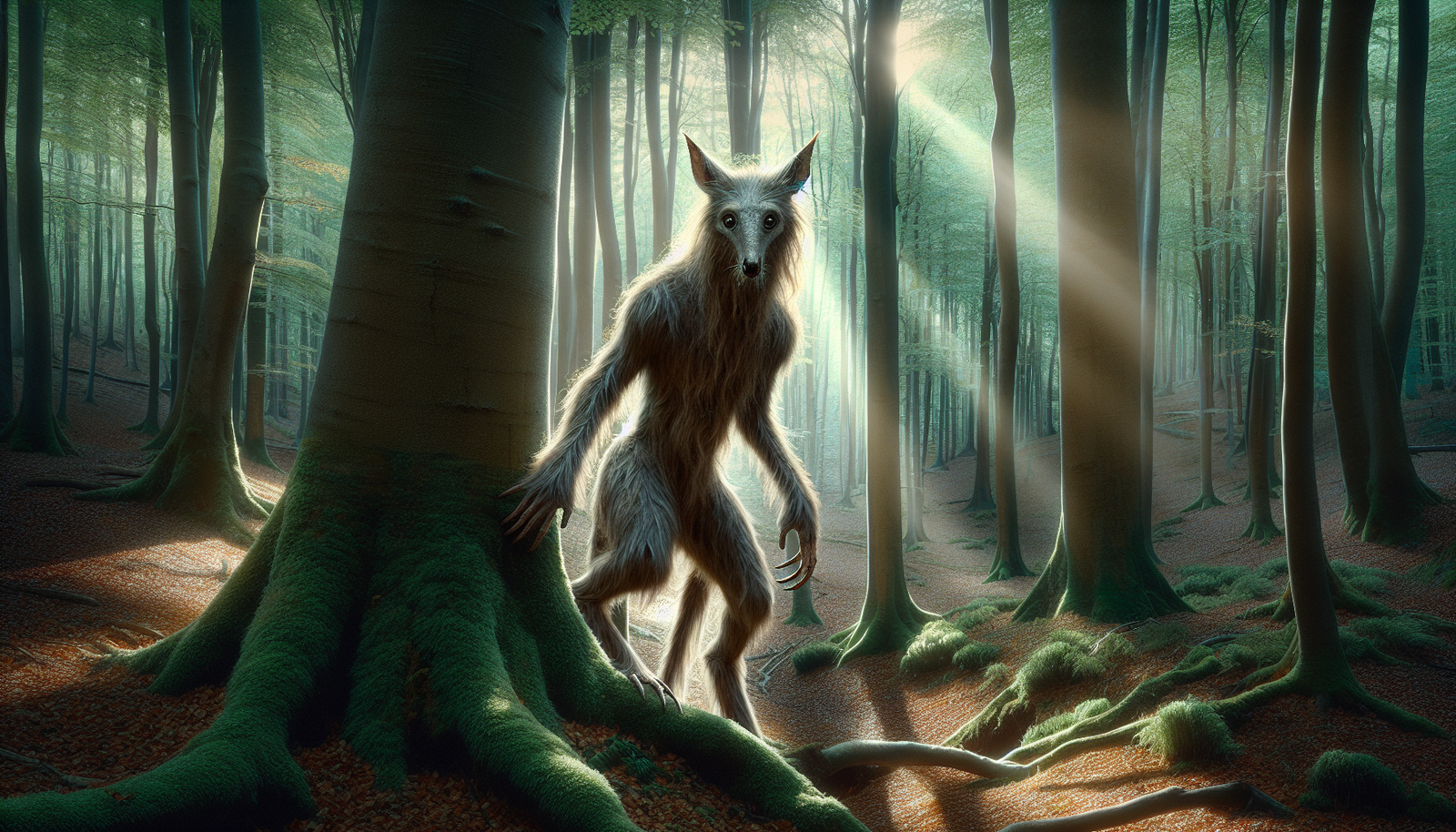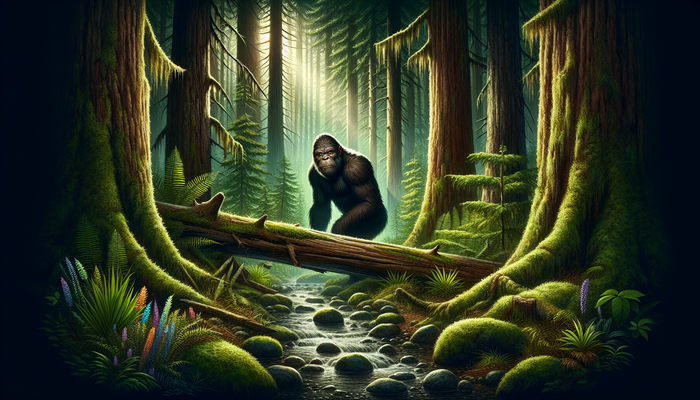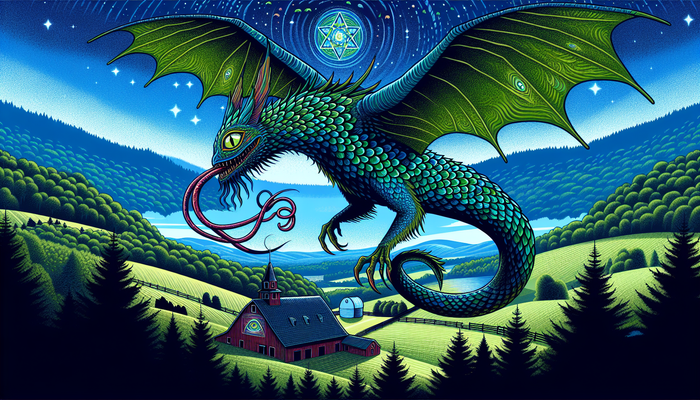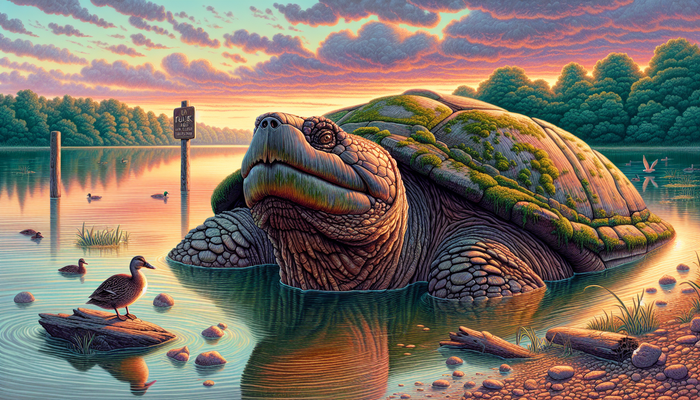Mysteries of the Wood Devil

By Jack Sullivan, Cryptozoologist
The Birth of a Legend
The story of the Wood Devil didn't just appear out of thin air. Like many folkloric creatures, its origins are rooted in the experiences and imaginations of those who called the forests home. The first whispers of the Wood Devil emerged in the 1930s, a time when the lumber industry was booming in New Hampshire. Lumberjacks, spending long days and nights in the dense forests, began to share stories of a creature unlike anything they'd seen before.
These early tales painted a picture of a being that was both fascinating and frightening. The lumberjacks, hardy men not prone to flights of fancy, gave the creature various nicknames that hinted at its nature. "Glutton," they called it, suggesting a voracious appetite. "Indian devil," a name that evoked a sense of ancient, primal power. And "skunk bear," a moniker that spoke to its distinctive – and apparently unpleasant – odor.
But it wasn't until 1948 that the Wood Devil truly stepped out of the realm of campfire stories and into the annals of cryptozoology. George Lavoie, a hunter whose name would become forever linked with the Wood Devil, had an encounter that would set the template for future sightings.
Lavoie's story goes like this: He was at his hunting camp, likely enjoying the solitude of the forest, when he spotted something unusual. Standing behind a tree was a tall, hairy creature with a face that reminded him more of a horse than any animal he'd encountered in these woods. In a moment of panic or bravery (depending on who's telling the story), Lavoie raised his rifle and fired. But the creature, displaying an agility that belied its size, vanished into the forest.
When Lavoie went to investigate, all he found were oversized footprints – silent testimony to the strange encounter he'd just had. This incident, with its mix of the familiar (a hunter in the woods) and the fantastical (a horse-faced, bipedal creature), captured the imagination of locals and set the stage for the Wood Devil phenomenon.
Throughout the 1940s and 1950s, more hunters came forward with similar tales. Each story added layers to the growing legend. The Wood Devil, it seemed, was not just a one-off sighting but a recurring presence in the forests of Coös County.
A Portrait of the Devil
So, what exactly does the Wood Devil look like? If we piece together the various eyewitness accounts, a consistent image emerges – one that's both familiar and alien.
Picture, if you will, a creature that stands head and shoulders above the tallest human. Reports consistently put the Wood Devil at between 7 to 9 feet in height. But unlike the burly, ape-like depictions of Bigfoot, the Wood Devil is described as slender and agile. It's built for moving swiftly and silently through the dense New Hampshire forests.
The creature's most striking feature, according to witnesses, is its coat. Covered in long, shaggy fur that ranges from gray to a light tan, the Wood Devil seems perfectly adapted to blend in with the dappled light and shadow of the forest floor. This fur isn't just for show – it's thought to help the creature survive the harsh New England winters.
But it's the face of the Wood Devil that truly sets it apart from other cryptids. Witnesses describe a visage that's more equine than simian, with a long, horse-like snout and small, dark eyes. This unusual facial structure has led to speculation about the creature's origins and its place in the animal kingdom.
The Wood Devil's hands and feet are said to be disproportionately large, with long, curved claws. These appendages would be perfect for climbing trees or digging for food, adding to the creature's adaptability in its forest home.
One detail that comes up frequently in Wood Devil lore is its smell. Many accounts mention a strong, unpleasant odor associated with sightings. This characteristic is so prominent that it contributed to one of the creature's nicknames: "skunk bear." Whether this odor is a form of defense, a result of its diet, or simply a natural musk is a matter of debate among cryptid enthusiasts.
The Elusive Forest Dweller
Perhaps the most intriguing aspect of the Wood Devil is not its appearance, but its behavior. Unlike some cryptids that are known for aggression or confrontation, the Wood Devil is renowned for its shyness and elusiveness.
Eyewitness accounts paint a picture of a creature that goes to great lengths to avoid human contact. The Wood Devil is primarily nocturnal, preferring to move under the cover of darkness. However, there have been daytime sightings, usually in the most remote areas of the forest where human presence is rare.
One of the most fascinating behaviors attributed to the Wood Devil is its method of evasion. When spotted, the creature is said to use the trees as cover, rotating around the trunk to keep it between itself and the observer. It's a tactic that speaks to a level of intelligence and adaptability that goes beyond mere animal instinct.
If there are no trees available for cover, the Wood Devil employs another strategy – perfect stillness. Witnesses report seeing the creature stand absolutely motionless, blending in with its surroundings so effectively that it's often mistaken for a oddly shaped tree or a shadow.
But what happens when these tactics fail, and the Wood Devil realizes it's been spotted? This is where the creature earns its devilish moniker. Accounts describe a blood-curdling scream that echoes through the forest, followed by the creature's rapid disappearance into the undergrowth. This scream, more than any other feature, has contributed to the Wood Devil's fearsome reputation.
When it comes to diet, the Wood Devil appears to be an opportunistic omnivore. Based on tracks and other signs found in areas of reported activity, researchers speculate that the creature feeds on a variety of small game, fruits, and insects. There's also evidence to suggest that it may scavenge carrion, especially during the harsh winter months when other food sources are scarce.
The territorial nature of the Wood Devil is another point of interest. While the creature generally avoids human contact, there have been reports of hikers going missing in areas associated with Wood Devil sightings. While it's important to note that there's no direct evidence linking these disappearances to the creature, these incidents have added an element of danger to the Wood Devil's mystique.
A Cultural Icon
The Wood Devil is more than just a creature that may or may not roam the forests of New Hampshire. Over the decades, it has become a significant part of the region's cultural identity, a symbol of the wild and untamed nature that still exists in the modern world.
For the people of Coös County and beyond, the Wood Devil represents the mysteries that still lurk in the shadows of our forests. It's a reminder that despite our technological advancements and urban sprawl, there are still places where the unknown can thrive. The creature embodies themes of survival, adaptation, and the delicate balance between humans and nature.
This cultural significance is reflected in the way the Wood Devil has inspired local artists and writers. Paintings depicting the creature in its forest habitat adorn the walls of local establishments. Short stories and novels use the Wood Devil as a central figure, often exploring themes of man versus nature or the consequences of encroaching civilization.
The Wood Devil has also found its way into more academic circles. Cryptozoologists – those who study animals whose existence is unproven – have long been fascinated by the creature. Documentaries exploring the phenomenon have been produced, featuring interviews with eyewitnesses and investigations into potential Wood Devil habitats.
In many ways, the Wood Devil serves as a bridge between the rational, scientific world and the realm of folklore and imagination. It challenges us to consider what might still be out there, waiting to be discovered.
Modern Sightings and Changing Perspectives
While the heyday of Wood Devil sightings was in the mid-20th century, reports of encounters have continued into modern times, albeit with less frequency. This decline in sightings has led to various theories about the creature's fate in the face of increasing human encroachment on its habitat.
One notable modern sighting occurred in 1997. Bill Driscoll, driving on Route 26 near Errol, reported seeing a nine-foot-tall creature with gray fur running across the road. The creature, according to Driscoll, moved with a speed and agility that defied its size, disappearing into the forest before he could get a better look.
This sighting, like many others in recent years, shares similarities with the classic Wood Devil descriptions from decades past. However, there are some who believe that the decrease in sightings isn't due to the creature's extinction, but rather its adaptation.
As human development has expanded into previously wild areas, some theorize that the Wood Devil has simply become better at avoiding detection. Its already impressive camouflage and evasion tactics may have evolved, allowing it to coexist with humans without being seen.
Others point to changes in human behavior as a reason for fewer sightings. With fewer people venturing deep into the woods for extended periods, as was common in the logging days, there are simply fewer opportunities for encounters.
The Wood Devil in the Digital Age
In the age of smartphones and social media, you might expect that if the Wood Devil exists, we'd have clear photographic or video evidence by now. The lack of such evidence is often cited by skeptics as proof that the creature is nothing more than a myth.
However, believers argue that the very nature of the Wood Devil – its shyness, speed, and camouflage abilities – make it particularly difficult to capture on film. They point out that even known animals can be notoriously hard to photograph in the wild, let alone a creature that actively avoids human contact.
The internet age has, however, provided new platforms for sharing and discussing Wood Devil experiences. Online forums and social media groups dedicated to cryptids buzz with discussions about potential sightings, theories about the creature's nature, and debates about its existence.
These online communities have also led to increased amateur research efforts. Armed with trail cameras and GPS devices, enthusiasts venture into the woods of Coös County, hoping to capture evidence of the Wood Devil. While these expeditions have yet to produce definitive proof, they've contributed to a growing body of anecdotal evidence and have kept interest in the creature alive.
The Science Behind the Legend
While the Wood Devil remains firmly in the realm of cryptozoology, some researchers have attempted to approach the phenomenon from a more scientific angle. These efforts often focus on trying to explain the sightings through known biological or psychological phenomena.
One theory suggests that the Wood Devil might be a case of misidentification. New Hampshire is home to black bears, and some argue that a bear standing on its hind legs could, in the right light and with a dash of fear or imagination, be mistaken for a Wood Devil.
Others point to the possibility of an unknown primate species. While the idea of an undiscovered large mammal in New England might seem far-fetched, cryptozoology enthusiasts often cite the example of the mountain gorilla, which was once considered a myth before its official discovery in 1902.
Psychological explanations have also been proposed. The concept of pareidolia – the tendency for the human mind to see patterns or familiar shapes in random stimuli – could explain some sightings. In the dim light of the forest, a oddly shaped tree or a shadow could be interpreted as a mysterious creature.
Despite these attempts at scientific explanation, the Wood Devil remains an enigma. The lack of physical evidence – no bodies, no clear photographs – keeps it firmly in the realm of cryptids, alongside Bigfoot and the Loch Ness Monster.
The Future of the Wood Devil
As we look to the future, what can we expect for the legend of the Wood Devil? Will it fade into obscurity as the forests of New Hampshire continue to shrink and modernize? Or will it adapt and evolve, much like the creature itself is said to do?
One thing is certain: as long as there are forests in New Hampshire, there will be those who venture into them hoping for a glimpse of the mysterious Wood Devil. The allure of the unknown is a powerful force, and the idea that there might still be undiscovered creatures in our world continues to captivate the human imagination.
Conservation efforts in Coös County and surrounding areas may play a crucial role in the future of the Wood Devil legend. As more land is protected from development, it preserves potential habitat for the creature – whether it exists or not. These protected areas also ensure that there will always be wild spaces where the imagination can run free.
The Wood Devil has also become a tool for environmental education. Some local conservation groups use the legend as a way to engage people, especially children, with the natural world. By sparking curiosity about the Wood Devil, they hope to foster a broader interest in forest ecosystems and wildlife.
In the realm of popular culture, the Wood Devil continues to inspire. From local art to indie films, the creature serves as a muse for those looking to explore themes of nature, mystery, and the human relationship with the wild. As long as these creative works continue to be produced, they'll keep the legend alive for new generations.
The Enduring Mystery
In the end, the true nature of the Wood Devil remains a mystery. Is it a flesh-and-blood creature that has managed to elude scientific discovery? A case of mistaken identity blown out of proportion by folklore and imagination? Or perhaps something in between – a symbol of our complex relationship with the natural world and the unknown?
Whatever the truth may be, the legend of the Wood Devil serves as a reminder of the power of storytelling and the human need for mystery. In a world where it often feels like every corner has been explored and every secret uncovered, the Wood Devil represents the possibility that there are still wonders waiting to be discovered.
For the people of New Hampshire, and for cryptid enthusiasts around the world, the Wood Devil is more than just a potential undiscovered species. It's a connection to the past, a symbol of the wild, and a challenge to our understanding of the natural world.
As long as the forests of Coös County stand, there will be those who venture into the woods, eyes and ears alert for any sign of the elusive Wood Devil. And who knows? Perhaps one day, someone will emerge from those woods with the evidence that transforms this creature from legend to reality.
Until then, the Wood Devil will continue to roam the forests of our imagination, a testament to the enduring power of mystery and the wild spirit of New Hampshire's woodlands. Like the legendary Devil's Wood of folklore, these forests hold secrets that continue to captivate and inspire. Some enthusiasts even make pilgrimages to areas associated with Wood Devil sightings, hoping to experience the thrill of the unknown. And for those who can't make the journey themselves, there are always documentaries that explore the legend of the Coös County Wood Devil, keeping the mystery alive for a wider audience.
From Bigfoot to UFOs: Hangar 1 Publishing Has You Covered!
Explore Untold Stories: Venture into the world of UFOs, cryptids, Bigfoot, and beyond. Every story is a journey into the extraordinary.
Immersive Book Technology: Experience real videos, sights, and sounds within our books. Its not just reading; its an adventure.



























